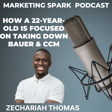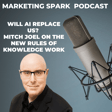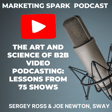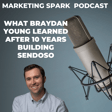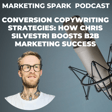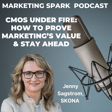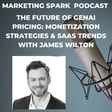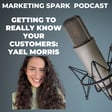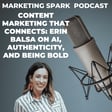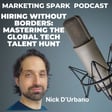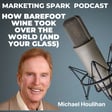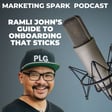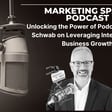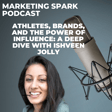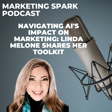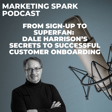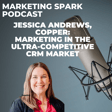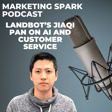Become a Creator today!Start creating today - Share your story with the world!
Start for free
00:00:00
00:00:01

Mastering LinkedIn with Florian Decludt: Strategies for Entrepreneurs
In this episode of Marketing Spark, we dive deep into the world of LinkedIn with Florian Decludt, a renowned strategist who's been guiding entrepreneurs on leveraging this powerful platform.
Florian's insights are gold whether you're looking to build your brand, network effectively, or supercharge your content engagement.
Discover the dos and don'ts of posting, tactical advice to maximize engagement, and the secrets behind a standout LinkedIn profile.
If LinkedIn is on your radar (and it should be!), this is an episode you won't want to miss.
Transcript
Introduction to Marketing Spark with Florian DeClute
00:00:00
Speaker
Hi, it's Mark Evans, and you're listening to another episode of Marketing Spark, where we dive into the latest trends and strategies in the world of B2B and SaaS marketing. Joining us today is Florian DeClute, a digital marketing expert who turns founders into thought leaders and helps clients leverage LinkedIn to attract, engage, and win customers.
00:00:23
Speaker
In today's episode, we'll be exploring Florian's approach to LinkedIn strategically and tactically, and how he guides clients who want to drive brand awareness, leads, and sales from the platform.
Understanding Thought Leadership
00:00:34
Speaker
Florian, it's great to have you on the podcast. Well, thanks for having me. Happy to be here. Why don't we start with a very, very high level question about which I'm sure you get asked a lot.
00:00:46
Speaker
What is thought leadership? Yes, it's a loaded question, but I'm interested in how you define it. And what do people most misunderstand about what it is, why it's important, and how it happens? So that's a great question. And like you said, people get it wrong a lot because the way I see thought leadership is being known as the go-to person to solve one specific problem for one specific kind of people in one specific way.
00:01:17
Speaker
And people usually think like, oh, in order to be a fault leader, I need to be Bill Gates or Gary Vernerchuk or Richard Branson and have these millions of followers. I need to have all these business success. I need to get all these likes on my post. And the truth is, it's not because you can be a micro fault leader in your niche, like being the number one expert to market, for example, financial software in the United States, that could be a
00:01:45
Speaker
a small niche that you can be a thought leader in because you are the best in the world at doing that and you're actually sharing your thoughts online and that's just providing value for your audience. On LinkedIn, I see a lot of people talk about thought leadership and my point of view, at least how I see it, is a lot of people overthink thought leadership. They believe that if you put together a strategic plan to become a thought leader and you follow these steps,
Simplifying Thought Leadership
00:02:15
Speaker
then that will make you a thought leader. And maybe my approach is a little more amateurish, if I can use that word. I believe that a thought leader is generous with their time, shares their insight, is open to conversation and willing to talk to people about what they think, why it matters, and as important, listen.
00:02:39
Speaker
Maybe it's a simplistic approach to thought leadership, but I think people try too hard. I think they believe that thought leadership is a marketing campaign that they can execute on. And I don't see that at all. What are your thoughts?
00:02:55
Speaker
that people overthink it, definitely. I think LinkedIn experts, put experts, quote unquote, are kind of responsible for it because this is what they sell pretty much. They sell frameworks, they sell programs. So it's about building the value of it. And so you got to make it look very complicated and very strategic. Now, of course, there's ways that you can make it very subtle and very strategic. And you look at some of the best people on LinkedIn, some of the
00:03:23
Speaker
highest performing creators, people like Justin Welsh, like Richard van der Blum, they are very strategic and very deliberate in their strategy. Now, does that mean that you need to be extremely deliberate and extremely complex in your approach, especially when you get started? Absolutely not. I mean, you look at all the greatest creators out there, the one thing they had in common is when they started, they had no idea what they were doing. And all they did was
00:03:49
Speaker
was share what they knew, share one piece of information today that would be helpful for their audience based on the experience that they had. So it's just about their generosity is kind of waking up every day and thinking, what could be one small piece of insight that I can share to my audience that will help them
00:04:06
Speaker
achieve their goals and then as a secondary goal, like position myself as someone who produces valuable content to solve a specific problem and therefore position myself as a thought leader.
LinkedIn for B2B Connections
00:04:16
Speaker
Thought leadership is a result of helping people consistently and being recognized as someone who provides value every single day. You don't just show up and say, oh, I'm a thought leader. Listen to me. You kind of earn that thought leadership by showing up every day, like you said, being generous with your time, interacting with the audience and just being helpful.
00:04:36
Speaker
I want to connect the dots between thought leadership and LinkedIn, but before I do that, I'd like to ask you about why you've embraced LinkedIn as the platform that you want to help people succeed.
00:04:50
Speaker
A lot of people like you and I spend probably too much time on LinkedIn, but for people who are looking at the platform and understanding that it has changed and it's not just a place where you look for jobs or get recruited, but it's a place for sharing information. What is it about LinkedIn that has attracted you and why do you see it as the platform or one of the platforms for business professionals? What I like about LinkedIn is two things.
00:05:20
Speaker
Overall, if you're in B2B, you can boil it down to the platforms. So you have LinkedIn on one side, and then you have Twitter slash X on the other side. The reason I went on LinkedIn at first is just because the atmosphere, the overall vibe of the platform is a little more positive. And one of the biggest things that I think is stopping people from posting regularly and becoming far leaders is having the confidence and the safety to put their thoughts out there and not being
00:05:50
Speaker
for it. I chose LinkedIn kind of by default because I'm kind of like my probability of being insulted and being mocked for what I'm saying is a lot lower than on Twitter. So I chose LinkedIn and then it was kind of a happy happenstance because one thing that LinkedIn provides is because of all its premium features, like self navigator and self navigator is a wonderful tool if you want to build full leadership, you can target people extremely specifically. So when you
00:06:19
Speaker
start combining an outreach strategy with your thought leadership, then you can target the right people very effectively by connecting with them. And you can send them messages, you can send them cold messages very precisely. So it's a lot easier to target the right kind of people on LinkedIn than it is on Twitter, just because of all of the premium tools that come with it.
00:06:41
Speaker
Let's connect the thread of thought leadership to LinkedIn. Are there characteristics that make someone an effective thought leader on LinkedIn? And you probably answered this question already, but
00:06:55
Speaker
What are the steps that one would take if you're looking at LinkedIn and you're saying to yourself, I do want to be a thought leader. I do want to be known as the expert in my specific field, and I do want to leverage LinkedIn. So sort of a two-sided question here. What are some of the key characteristics and how do you make that happen? I think the key characteristic is very, very focused. I think the best thought leaders are not the ones who have massive audiences. The best thought leaders have actually
00:07:25
Speaker
very small audiences, but they focus on one very specific problem and one very specific kind of people. If they don't try to solve the biggest problems of the world, they try to solve small painful problems that a very small set of people are experiencing, and they become the go-to person for it. So for example, one of the most effective thought leaders that I've trained
00:07:48
Speaker
He has, he had 6,000 followers when he started back in November. Now he has 8,000 followers. His posts get on average, I think 30 to 40 likes. Not a successful influencer by any means in terms of metrics, but he gets about one lead a day and each lead is worth $100,000. That's...
00:08:12
Speaker
Great. And it's amazing that someone has taken that approach to LinkedIn, but it also talks to one of the realities of LinkedIn is that people get thrown by engagement, by views and likes and comments. And at the end of the day, your success in many respects is based on the financial success of your clients.
00:08:33
Speaker
Do you think that people get distracted by vanity metrics on LinkedIn? Because there's a lot of talk about, hey, my posts are really popular, but they never talk about the correlation between popularity and business. Do you think that people see engagement views, et cetera, as vanity metrics? Oh, yeah. It's a difficult question because what happens is, ultimately, you're right.
00:08:59
Speaker
You should define success on LinkedIn by how much money it's making for you. I mean, that's why we should be spending time on LinkedIn, ultimately. I mean, it's great to spend time to share with people and everything, but ultimately we're building, we're business people, we're building a business, but we got to make a living somehow. But most people still approach LinkedIn by how do I get views? How do I go viral? How do I make hairstyles that sell? How do I create the right cheat sheet? I go off these very tactical things about how to get more views.
Beyond Vanity Metrics
00:09:29
Speaker
It's kind of like a race to the top of the bottom depending how you look at it, where we have all these influencers trying to get as many views as possible and they get 400 likes, 500 likes, they get like 80,000 followers, 90,000 followers, 100,000 followers, and it's great. But then if you look at the business numbers, I was talking to a creator yesterday. I think he has 38,000 followers, pretty successful guys, getting lots of engagements on his posts a lot more than me.
00:10:00
Speaker
But then I was asking him about his rates and he was telling me, yeah, oh yeah, for what I do, it's like $1,500. And I'm like, well, you do all these things and most you can extract out of a single prospect is $1,500. That's ridiculous. Jump change. But then at the same time, I have my client who his micro influencer, not successful by any means in terms of metrics, in terms of likes and engagement or something like this, he's making seven figures off LinkedIn.
00:10:27
Speaker
because he's focusing on the right metrics, which is, okay, getting the likes is great. Am I getting the likes of the right people? Am I getting DMs? That's great. Am I getting DMs from the right people? Am I getting comments? Great. Am I getting comments from the right people? And that's all that matters. But the thing is, it's also very human to
00:10:50
Speaker
go around and say, oh, this guy's getting 100 likes. I'm going to get 200 just because I want to show this person that I'm better than them. So it's a very dangerous game. And that's how the platform is designed. But back to your question, it's really easy to get caught up in vanity metrics. And I think in the business of
00:11:12
Speaker
LinkedIn coaching, unfortunately, you have to kind of play that game if you want to get customers because ultimately that's what customers are looking for. They want to get views, they want to go viral, they want because they associate file leadership with being massive. So it takes a lot of education to make them realize, yeah, I mean, that's great for your ego, but your wallet probably wants you to be more focused and focus more on talking to the right people.
00:11:37
Speaker
There is a lot of, I would say, generic go through the motions content on LinkedIn. People have jumped on the bandwagon simply because they want to be there. I'm curious about your take on how you help creators and entrepreneurs identify their unique voice and perspective because the ability to differentiate yourself and stand out and offer
00:12:05
Speaker
an interesting perspective matters when you're trying to attract the right customers and business. So how do you help clients to find their personal brand on LinkedIn? And as important, how do they discover and nurture the people that matter to them?
00:12:22
Speaker
We have a couple of ways to go about it. The first question they need to ask themselves is, do they want to be creator centric? Or do they want to be audit centric? So, creator centric being, do they want to talk about themselves and their company and their journey? So that's very effective. For example, if you're launching a startup, and you're starting from scratch, and you kind of like making a reality show out of your startup. So I know a couple of creators who did that, and they did that very successfully.
00:12:48
Speaker
Or do they want to be audience centric, meaning that they have an audience in mind, like let's say, for example, they are an agency and they are targeting fintech startups to help them with their LinkedIn ads, for example. So, or are they going to focus on the startup on these people and say like, okay, I'm going to list out all the problems that they might have. And I'm going to solve one of the problems every single day for content.
00:13:13
Speaker
So that's the first thing that they need to figure out. It's like, what kind of angle am I going to take? Because then, depending on the angle, it's going to be very different strategies, very different formats as well. Because when you are a creator-centric creator, a lot more videos, a lot more selfies, a lot more pictures, things like this. When you're talking about audience-centric, you're going to use a
Content Strategy and Personal Branding
00:13:34
Speaker
lot more text, carousels, infographics in order to provide as much value as quickly as possible to your audience.
00:13:41
Speaker
That's the first thing to go about it. Now, in terms of helping them finding their voice, the thing is people already have a sense of what they want to talk about. It's just if they have ideas, but it's about getting them to express, articulate those ideas and put them into both. So my goal is to help them figure out what kind of value that they can provide to their audience. And then through conversation,
00:14:11
Speaker
extract the value out of it. Okay. So you can make a post about this. You can make a post about that. You can make a post about this. Because oftentimes what happens is they're so busy, like founders are so busy with their, with their company and managing HR, managing product development, marketing, all these things that they don't realize that all of, if they have a ton of post ideas in their head, they just, they don't know, they don't know they're there. Right. So for my job is to help them extract it, extract all those post ideas and then group them into different themes. So that's why you don't end up talking about the same thing over and over again.
00:14:41
Speaker
And in terms of finding your voice, it's about going through the motions. It's about posting regularly and then finding out what works, like what generates, what generates interest, what doesn't generate interest and generating interest from the right people. So how do you define the right person? That really depends on what stage you are at. So let's say you are an established business and you're trying to diversify your acquisition channels and you want to incorporate
00:15:11
Speaker
some more needed inbound, then you want to look at your current customer portfolio and look, okay, who are my top five customers in terms of who do I love working with? And if they pay me well, and this is just great, what do they have in common? And then how can I target these people in order to get more of them from LinkedIn? And you can use tools like Sales Navigator to help make that happen. For example, you can use Sales Navigator. So let's say you find out that
00:15:41
Speaker
your best customers are all using HubSpot for some reason, then you're going to put in the filters, I want all the other people, I only want to filter companies that are working with HubSpot. Because this is something that you identified as a common denominator between all the, all the best companies. And so that way, and ideally, you want to have a list of 100 to 200 companies that you want to work with and that are ideal. And then you start adding the leadership to your network.
00:16:11
Speaker
And so that way they will start seeing your content regularly. And even if they don't necessarily engage with it, that there will be a strong probability that they see it. And then at one point when they face a problem that you're solving, you'll be the first person that they reach out to. You've worked with creators from various industries. Can you share some case studies or examples of content strategies that have
00:16:30
Speaker
yielded particularly strong results on LinkedIn. I love real-world stories about entrepreneurs and creators who are being successful on LinkedIn. It would be great to hear an example of one of your clients who's really kicked it. I can actually think of two clients. The first client was actually my employer, Red Hot Advertising. It's a growth marketing agency. I used to work with them. Now I work with them on freelance basis.
00:16:57
Speaker
The strategy was, it was a brand new company and the goal was to generate some inboundities for content. So I worked with the co-founders in order to put together a content strategy so that they could attract their ideal customers. And so it was back in January 2022.
00:17:17
Speaker
I sat down with one of the co-founders, Pierre. So back then, I think he had about 500 followers, like not active on LinkedIn, just LinkedIn equals CV, like typical. I started posting. And so for him, the first thing that we figured out was getting used to posting. For him, his biggest fear, he still had that block against posting and sharing his ideas. So for him, it was about getting him comfortable. So the first strategy was not to have any strategy, just like get used to.
00:17:47
Speaker
the process of posting, and then once you're used to it, then you can start being more deliberate and focusing a little more. So we did that for about a month. And then for him, it was about, then what we did is that we identified the needs that we identify, yeah, we identify what problems the people we were working with had, what did they have in common. And so then we started addressing it in our content. So for example, we found out they had strategic problems. Like they had a product, they didn't know how to grow it.
00:18:18
Speaker
They had a problem finding their target audience. They had problems building sales funnels. They had problems choosing between different acquisition channels. And so then we started creating all of those content themes about different topics of worth marketing. And then we started declining it into like strategic and tactical levels. So for example, if you take the topic of LinkedIn ads, okay, so why should you use LinkedIn ads? What's a good LinkedIn ad strategy?
00:18:45
Speaker
So that would be more strategic topic, but then you can have, we can go more tactical and say like how to create LinkedIn ads for, for B2B FinTech company. And then you can go into a case study. Okay. You have a $3,000 budget. This is how you should set up your LinkedIn ads. So then you have different levels of content. And so in terms of metrics, so it's generated about, yes, multiple seven figures in pipeline.
00:19:11
Speaker
It's a seven figure agency now. And in terms of his personal brand, he went from 500 connections such followers to about 45,000 and high quality marketing leaders in his niche. And he's getting about two to three inbound leads every single week.
Navigating LinkedIn's Algorithm
00:19:30
Speaker
One of the realities of LinkedIn and the way that the algorithm works, and we can talk about the algorithm later and how you play with it or adjust to it is the idea that
00:19:42
Speaker
You have to, or the platform encourages you to create content consistently. And I see a lot of creators, high profile creators, publish content that ranges in quality. And this is my perspective. Some of it's really good and some of it, not so much. So how do you produce content consistently without sacrificing quality? The first thing is about clarity.
00:20:10
Speaker
it's about knowing exactly what you're going to talk about. Because if you see a pose that's just a piece of content that you throw out there, then the quality is going to vary a lot. Because sometimes it's really going to hit, sometimes it really is going to miss. However, if you see a piece of content as an answer to a specific question, then your hit rate is going to be a lot higher. So you might not go viral, but you're not going to bomb either because that is going to hit that standard and it's going to provide a certain standard of value to your
00:20:40
Speaker
to your ideal audience. So by having that system and knowing exactly what problem you're solving for your content, then it helps you focus a lot more specifically and be able to create high quality content at scale. And then the second part is about knowing
00:21:00
Speaker
how to create a good post. What are the best practices for creating a good post, creating good carousels, creating hooks. You have lots of advice on it on LinkedIn. And then just put it into a prompt on chat GPT and then help you generate a base for it. So instead of having to write every single post from scratch, you can always generate a draft and then
00:21:23
Speaker
I work from there. I have a specific prompt for hooks. I have a specific prompt for carousels. I have a specific prompt for text posts that just allows me to save a ton of time and be able to scale my content creation. Because yeah, the truth is when you're a founder, you don't have two hours to spend creating the perfect post. You have better things to do. So either you have a strategy combined with tools to help you scale that more quickly or you just hire a ghost writer.
00:21:52
Speaker
One of the realities for LinkedIn creators is understanding the algorithm, which constantly changes. And it often happens without any warning from LinkedIn. They just announced that, or sometimes they don't even announce that the algorithm has changed. People see engagement drop and views drop, and then there's a state of panic in the industry.
00:22:14
Speaker
And among the creator community, how do you stay current with best practices? What resources or people do you leverage to make sure that you understand how the algorithm works and how it's changed? That's a great question. And the way I look at it is who does the algorithm work for?
00:22:38
Speaker
Because a lot of people get it all wrong. People think that the algorithm's job is to serve creators. The algorithm doesn't work for creators. The algorithm works for LinkedIn. So in order to understand how the algorithm works, you have to understand how LinkedIn works, how they make money. They're here to make money and they're very, very in business. And the algorithm is the number one employee. So the way they make money, they make money through subscriptions like sales navigator, recruitment and things like this. And then they make money through selling ads.
00:23:08
Speaker
So pretty much the more time you spend on LinkedIn, the more valuable you become because they can show you more ads and you have a higher probability of clicking and that brands spend more money on it. So ultimately, the way you got to look at the algorithm is how can LinkedIn get more people to spend more time on the platform? So the algorithm is not going to do anything that goes against that interest. So how does it impact content?
00:23:38
Speaker
With that in mind, what kind of behavior does LinkedIn want to see from creators? So they probably want creators that create every day because that way people show up at a specific time and it's 9 a.m. Mark's going to post, it's going to be a good piece of content. I got to check it out. And so that becomes part of people's habits and so therefore they show up on the platform more. And then it's about creating quality content.
00:24:05
Speaker
because if every single post you see is terrible and it's not useful, are you going to be able to what LinkedIn is? Yeah, I mean, it's great, but I try to spend time on TikTok and I think more fun doing it. So the next question is, okay, so how does LinkedIn measure the quality of the content? Okay, what's the formula? So there's lots of theories. The way I see it is,
00:24:33
Speaker
they look at how many people engage with a post. So they're going to look at how many people click See More, they're going to look at how many people stop to check out the post, they're going to look at how many people click on the carousels, they're going to look at how many people save the post, and then they're going to look at how many people like and comment on a post. So they're going to look at all these metrics, and then based on that, they're going to assign a score to a post and then give it more or less visibility.
00:25:03
Speaker
So for example, I don't know if you remember last year, there was a time where polls were super popular, right? Because while people click and that's an engagement on the, that's a piece of engagement. Well, this place is doing well. People are engaging. So we're, we're going to push it. And so everybody started creating polls.
00:25:23
Speaker
And then LinkedIn probably found out, I think we went a bit too far with polls, working too well, people are not too happy about it. Let's kill the polls and instead let's put some, some carousels in there. And it's been going on for a while. So I guess it's working pretty well for them. So again, every single time there's an algorithm change and you see your engagement dropping, it's about, okay, what can I do to get more people to pay attention to my content so they can come back to LinkedIn?
00:25:50
Speaker
more consistently.
Tools and Tips for Engagement
00:25:52
Speaker
Because ultimately, this is what they want. You did a post recently on... It was interesting to me because I create content on a consistent basis, but you did a post recently on how to boost engagement without creating content. What are the ways that people can make that happen? Because a lot of us in the creator community, it's all about content and content, but you're saying, nuh-uh, you can do something different. You can take
00:26:17
Speaker
a different approach. So what are the secrets to that strategic approach to LinkedIn? So again, it's about engagement, but it's about not just any kind of engagement. It's about engaging with right people. So the way it works is you got to find some creators in your niche. So for example, let's say you're targeting B2B SaaS founders. So you got to find people who are also targeting B2B SaaS founders, creating content.
00:26:45
Speaker
And you got to figure out what time they post. So that way you can put in an alert and, okay, I got to go on LinkedIn. I got to go on this profile and be one of the first people to comment. And you want to do that for two reasons. Number one, there's going to be more people looking at it.
00:27:04
Speaker
So therefore, your comment's going to have more visibility. And then if it's a thoughtful comment, and that's very important that it's thoughtful. If the comment is a great post, no one's going to, it's going to find you valuable. But if it's a thoughtful comment and it adds up to the conversation that people are like, Mark is a pretty insightful person. He seems to know a thing or two about B2B SaaS marketing. I should probably follow him. If you follow him this way, you can all, so you gain followers this way. You also able to.
00:27:34
Speaker
start conversations, because people might react to your comment, and then you're able to start conversations in your comment. And then, most importantly, you're able to attract the attention of the post creator. And they will have a higher probability that they answer your comment. And therefore, you're able to start an interaction. And why is it so important that it's about the right people and not just commenting on any post? Again, you don't want to have any kind of audience, you don't want to have
00:28:02
Speaker
100,000 people in your audience that are not qualified, you want to have 1,000 to 2,000 to 3,000 people who match your ideal customer profile perfectly. And so if you target the creators who share that ideal customer profile with you, then you're going to create a much more valuable audience for yourself, and you'll be able to grow organically without having to post.
00:28:28
Speaker
Over the course of the conversation, you've mentioned a couple of tools, sales navigator, chat GPT that help you create content for LinkedIn without giving away your trade secrets. What are the tools in your LinkedIn marketing stack to create content, distribute content, that kind of thing? So it's actually very simple. I use Canva to create care cells. I use chat GPT to.
00:28:58
Speaker
to help me, to help me scale with ideation, creating your posts, creating the hooks and things like this. I use Notion to create my content calendar and I use Sales Navigator to find the right people.
00:29:14
Speaker
And that's it in terms of, I do schedule my posts, but I use LinkedIn to schedule my posts. I use LinkedIn analytics to analyze my posts because again, what I'm most interested in is business. I don't really care about what posts gets most used or whatever. I'm more interested into other, other more meaningful business metrics.
00:29:35
Speaker
And that's it. It's about simplicity, ultimately. I think one, one thing also is it's, it's becoming a technician's word. It's like, who gets the best tech stack and who gets the best, the latest tool to do X, Y, and Z. Well, ultimately it's, it's, it's a writer's game, right? So you want to, you want to keep it simple, as simple as possible. Don't get too bogged down into the specifics or how to do it perfectly. Ultimately you want to get started and then when you hit a problem, when you find something that you can optimize, you can always find a tool for that.
Conclusion and Final Advice
00:30:06
Speaker
That's really great advice. My tools are, are in the same realm. The one tool that I do use is authored up, which is a tool to write content for LinkedIn. I was using shield as an analytics platform, but I, I wasn't really.
00:30:23
Speaker
terribly interested in my analytics. I'm more interested in engagements and conversations. So I backed off of that one. But thanks you for all the great insight about LinkedIn. I hope we provided people with some tips and tools and direction on how to make the platform work better for them. Where can people learn more about who you are and what you do?
00:30:46
Speaker
So the best way is just to hop on my LinkedIn profile and venture me a DM. I check them about once or twice a day. So I'm more than happy to continue the conversation there. Thanks for listening to another episode of Marketing Spark. If you enjoyed the conversation, rate it and subscribe via Apple Podcasts, Spotify, or your favorite podcast app.
00:31:04
Speaker
and share via social media. And if you're a B2B or SaaS company looking for more sales and leads, but struggling to do marketing that makes an impact, we should talk. You can reach me at mark, at markevans.ca or DM me on LinkedIn. I'll talk to you soon. All right.
